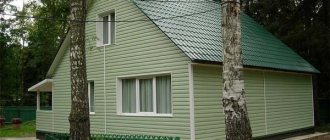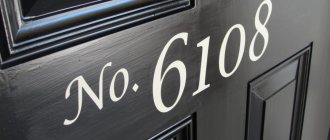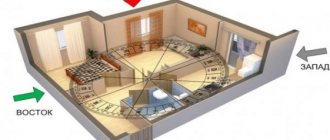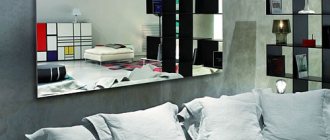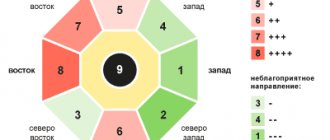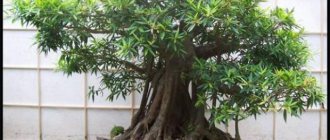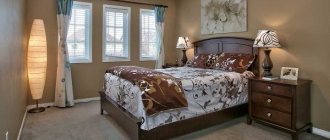Video:
Installation of facade tiles. Cheat sheet for the foreman. Anyone can install facade tiles, but this requires certain knowledge. In this story we will analyze the installation of facade tiles in stages.
A German-style house with a Japanese facade and a “cunning” roof. Having lived in Germany for a long time, Sergei Belov decided that he would build his house near Moscow based on local modern buildings. His large house with a basement and garage is built from aerated concrete, and Japanese fiber cement panels were chosen for the exterior. The roof, which only seems flat, also deserves attention. In the next part of the video, watch the story about the basement floor.
Instructions for installing a wet plaster facade. The facade insulation system based on polystyrene foam was developed in the USA in the early 60s of the 20th century and is still successfully used all over the world. In this video we will show detailed instructions for installing this system.
“Lubyanaya Izbka”, or the history of the reconstruction of a typical house. Having bought a plot of land with a summer house built according to a standard design, our forum member Dmitry decided to turn it into a home for full-time living. Eco-friendly materials were chosen for the reconstruction - unusual insulation and shingles for the front cladding. Much of the house was done with our own hands. Let's see what the house looks like and analyze the stages of its transformation.
Facade cladding with decorative tiles. Cladding with clinker tiles, natural or artificial stone looks advantageous and enhances any home. Experts will tell and show you how to perform the cladding correctly, depending on the design of the façade walls and the type of wall material of the structure.
Painting the wooden facade of a building. Many builders know that such house facades as wooden ones need to be well protected, because in the future this will save a lot of money. We will tell you and show you how to paint it correctly so that it remains in its original form for a long time.
Facade renovation using fiber cement siding. When facing their home, absolutely all developers hope that it will please them with its appearance for a very long time. Time wasted, money wasted, and a lot of it. And it can be very disappointing if after a few years everything becomes unusable. Using the example of a house from the story, we will show what it means to renovate a cracked facade of a frame house using fiber cement siding.
What is the facade of a house
The facade of a house, like the cladding of any building, is an ancient concept that designates the front side of a building, and the orthogonal projection of the house in the drawing is included in this concept.
Finishing serves not only for the visual perception of the structure, but is also responsible for the safety and durability of the entire building. Depending on the type of house, there are several types of facades:
- Front (main) facade.
- Street facades.
- End (side) facades.
- Courtyard facades.
- Park facades.
The exterior cladding of buildings is becoming a cultural heritage of various countries, due to the uniqueness of the architecture and innovative solutions in construction.
Architectural style
Photo of a private house
There are several main design styles for building cladding:
- Classic - the main distinguishing feature is the axis of symmetry and regular geometric shapes.
- Gothic - the main distinguishing feature is the desire to rise, expressed in the height of the building and the pointed roof.
- Romanesque - this style originated in the Middle Ages, and a huge number of castles are made in it.
- The Renaissance style is different from other styles; it is a borrowing of ancient architecture.
- Classicism style - in this style one can observe the rejection of decorative details.
- Baroque and Rococo - the styles are characterized by the presence of a large number of curvilinear shapes and details.
- Modern - differs from other styles by the rejection of rectilinear details and angles and the use of natural lines (natural).
Forum topics:
Facade window frames. A house looks truly beautiful if not only the finishing materials are tastefully selected, but also the windows are in harmony with the walls. Forum members discuss how to design them beautifully in this thread.
Facade cladding with brick-like tiles. A portal participant talks about his first experience of decorating a stone house with decorative tiles.
Fiber cement siding - selection, application, reviews. Fiber cement siding is one of the most popular finishing materials, which is favored by all homeowners. Our users discuss the features of working with it in the topic.
Flat slate facades. Despite the wide choice of materials, some developers decide to experiment. Forum members learned from their own experience what it means to install flat slate on the facade of a house.
Original and beautiful facades. Other people's examples always help to decide on the material. This topic presents ready-made solutions and photographs of the homes of portal users and more.
Facade thermal panels: pros and cons. Thermal panels, consisting of a layer of insulation and cladding, are designed to thermally insulate the walls of a building and give it a representative appearance. In this topic, portal users talk about their experience of purchasing, installing and using this material.
Exterior finishing
Application of plaster
The outer walls of houses can be load-bearing or play the role of enclosing structures - this is an important fact when choosing cladding. Facades can be of several types:
- Stone, made of natural or artificial stone.
- Brick, made of brick or clinker tiles.
- Wooden, made using wooden structures.
- Combined, such as half-timbered and chalet.
- Plastering, using various types of plaster.
- Glazed, made of glass.
- Hinged, ventilated, can be lined with porcelain stoneware, siding, stone, metal cassettes.
Decorative finishing can be applied to any of all types of facades. Small architectural forms give the building sophistication and uniqueness.
Architectural and structural elements of buildings
Structures consisting mainly of premises intended for living, production or other activities of people are called buildings. Buildings that have a special purpose are called structures.
Building classification
Based on their purpose, buildings are divided into residential, public and industrial. Residential include apartment buildings for permanent residence of people and dormitories for living during work or study.
Public buildings are intended for social services to the population and for housing administrative institutions and public organizations.
Industrial buildings serve to house industrial and agricultural production and provide the necessary conditions for people to work and operate technological equipment. Industrial buildings include buildings of plants and factories, transport, energy enterprises, etc. Agricultural buildings include buildings for keeping livestock, poultry, vegetable and grain storage facilities.
Depending on the material from which the walls are erected, buildings are distinguished between stone, reinforced concrete, and wood, and wooden buildings can be panel, volumetric block, panel, frame, cobblestone and log, i.e., chopped from logs. Depending on the type and size of the material and the method of performing the work, buildings are erected from small piece elements (brick) and from large-sized elements - large-block, large-panel. and after its removal, burning or smoldering stops (fibrolite, wood treated with fire retardants, etc.); combustible, when structures under the influence of fire or high temperature ignite or smolder, or char and continue to burn, smolder or char after the source of ignition is removed.
Back
Basic elements of buildings
Buildings consist of the following main parts: foundations, walls, ceilings, partitions, stairs, roofs, windows, doors, etc.
Foundations are the lower part of a building that absorbs the load from the building and transfers it to the ground (base). Foundations must be durable, strong, frost-resistant, resistant to overturning and against the action of aggressive and groundwater. The upper surface of the foundation on which the building rests is called the edge. The plane on which the foundation rests on the ground is called the base. Foundations can be wooden, rubble, rubble concrete, concrete, reinforced concrete. Based on the designs, foundations are divided into strip, column and pile foundations. For low-rise buildings, including one-story ones, the foundations are made of rubble stone.
Walls are parts of buildings that protect rooms from the external environment. In some cases, walls take the load from the floors and parts of the building located above and transfer it to the foundation. Walls that bear the load of their own mass and the mass of other parts of the building are called load-bearing, and walls that bear the load only of their own mass and the action of the wind are called self-supporting. Walls that only enclose the premises of buildings from the outside space and transfer their own mass within each floor to other load-bearing structures of the building are called non-load-bearing. If wall panels are attached to the frame or cross walls of a building so that each top panel does not rest on the one below, then the walls are called curtain walls.
Floors perform load-bearing and enclosing functions. The ceilings separating the lower floor from the basement are called basement, and those separating floors adjacent in height are called interfloor. The ceiling located above the top floor of the building is called the attic. Floors must be strong, rigid, sufficiently fire-resistant, easy to assemble, with the necessary heat and sound insulation. Depending on the design, the floors can be panel or beam; according to the degree of fire resistance - combustible, difficult to combust and non-combustible.
Partitions are an enclosing structure and are designed to divide the internal space of buildings into separate rooms. According to their purpose, partitions are divided into interior, inter-apartment, sanitary, etc. Partitions are made of brick, lightweight concrete, gypsum boards, and wood. They must have the necessary soundproofing properties. The floors in buildings are cement, ceramic tiles, linoleum, planks and parquet.
Ceramic floors are installed on staircase landings, at building entrances, in sanitary facilities, lobbies, etc. Parquet floors are made in residential and public buildings. Plank floors are found almost everywhere. Stairs serve to communicate between floors. They are made of wood, reinforced concrete and less often metal. Stairs can be one-, two- and three-flight. At the end of the flights, landings are arranged.
The roof is the load-bearing part of the building, protecting it from precipitation and serving to drain it beyond its boundaries. The enclosing part consists of the roof (the upper waterproof part of the roof) and the base for the roof. The load-bearing part of the roof includes rafters, wooden trusses, and arches. According to the design of the roof, there are one- and two-slope roofs, attic, non-attic, and combined. The attic roof consists of a rafter system, sheathing or continuous or sparse flooring, roofing. Combined roofs are those structures in which the upper part serves as a roof and the lower part serves as a ceiling. The elements of the rafter system are made of wood. Roofs can be asbestos-cement, roofing felt, tar paper, tiled and, less commonly, metal. Roofs are divided into pitched roofs and flat roofs (with a slope of less than 3°).
Windows are designed for natural lighting and ventilation of the room. They come in single, double and tricuspid types. Window units can be either paired or separate. Doors serve to connect rooms with each other, exit from rooms to the staircase and exit to the street. Doors come in single- and double-leaf types. Based on their design, doors are divided into panel and frame (panel) doors.
Back
Architectural and structural elements of buildings
Architectural and structural elements of buildings are shown in Fig. Plinth 17 is the lower part of the outer part of the wall, located above the foundation. Cordon 16 is the upper limit of the plinth. The projections of the wall form the cornice 4, 8, 13. If the cornice is located at the top of the wall, it is called the main 4. The part of the cornice protruding beyond the surface of the wall forms an overhang. Cornices located above window or door openings are called sandriks 14. Lintels 10 are elements that cover the opening from above and support the part of the wall located above it. The part of the wall located between the openings is called pier 7, 9. Niche 23 is a recess in the wall in which cabinets, heating devices, etc. are placed. The ledges in the wall formed as a result of reducing the thickness of the wall are called edge 21. Covering around the perimeter of the building intended to drain water from the building, is called a blind area 18. Protrusions in a wall with a rectangular section are called pilasters 23, and those with a semicircular section are called semi-columns 22.
Back
Facade of a house after time
Redecorating
Nothing lasts forever, just like the façade of a house. When using any materials, you need to monitor and care for the cladding of the building, then you will extend the service life of the finish. But when the time comes for repair or reconstruction, you should turn to specialists.
Expert opinion
For better perception and visual design, it is worth taking time to study the decor. The design should reflect all the architect's plans and savings on materials will be noticeable in 2-3 years, when they begin to deteriorate. When choosing a ventilated type, it is better to use stainless steel, and when plastering, be sure to prepare and level the surface.

